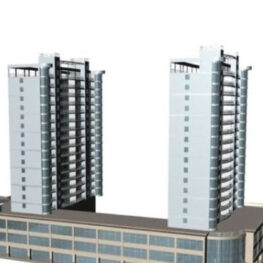Architectural Design With Revit Training

Autodesk Revit architecture is important in the design works of construction projects. Revit is a robust
Building Information Modeling BIM software that boasts various advantages when it comes to the
design process, collaboration and ultimately project results. Revit’s ability to create detailed and
accurate 3D models of buildings, infrastructure is one of the main advantages it has.
This will enable design and construction teams to see the proposed designs in a virtual environment,
making it easier for them to understand what they might mean. This software allows designers to
create intelligent building components including walls floors, doors windows and roofs that can be
easily modified and updated throughout the design process. 3D models created by Revit allow more
detailed communication between team members, clients and stakeholders so that everyone was
aligned to the project vision.
INSTRUCTORS:

IHIRWE Pacifique
ASSOCIATE TRAINER/ ARCHITECTURE DEPARTMENT

Gregory OGAH Anthony
TRAINER / ARCHITECTURE DEPARTMENT
Parametric modeling constitutes another considerable advantage of Revit. This means that any change done to the design is reflected automatically in every part of the model, guaranteeing consistency and accuracy. Construction company teams can easily understand the consequences of modifications in design and look into alternative options without having to edit each element manually. Its parametric modeling feature also facilitates fast design iteration and optimization thus yielding efficient and cheaper building designs.
3D models are not the only thing that Revit’s BIM is capable of. It also allows the connection and operations with different design specialties like architecture, structural engineering as well MEP, which stands for mechanical electrical systems. This integration aids in interdisciplinary coordination and collaboration reducing conflict and ensuring
an integrative approach to design. Shared BIM environment in Revit fosters collaboration among the team members thus helping to achieve higher efficiency and quality of project outcomes. Moreover, Revit provides sophisticated analysis tools that enable construction teams to evaluate their designs’ performance and sustainability. The software allows teams to perform energy analysis, lighting simulation and thermal performance evaluations enabling them optimize building efficiency as well minimizing impacts on the environment. By making these analyses an integral part of the design process, construction companies are able to develop buildings that result in more energy efficiency and sustainability thus enabling them to meet their clients’ growing demands for such attributes.
Revit also has extensive documentation capabilities that enable teams to produce construction drawings, schedules and specifications directly from the model. This simplifies the process of documentation and ensures that everything is recorded accurately and consistently within project’s paperwork. The fact that the software can automate and update these documents as a design matures also increases efficiency, decreasing potential errors. Turn your skills into actionable results by learning the critical skills required for both modeling and documentation workflows.
Here is what you can expect at the end of this training:
Upon completion of this training, participants will:
- Achieve the full potential of Autodesk Revit with a comprehensive training that spans every aspect of designing and constructing buildings right from sparking ideas to producing construction document.
- Explain the intricacies of designing both simple and complicated multistory structures, from initial concept development to final production readiness for issuing construction documents.
- Perfect the technique of creating multi-story, U-shaped stairs in detail while incorporating railings and editing railing paths as per your own design.
- Go deep into the process of creating topography and site modeling, to breathe life in your envisioned architectural ideas about its outer surroundings.
- Learn how to develop mass families, control masses, and use model-by-face tools that will enable you sculpt your structures elegantly.
- Effectively develop area schemes, plans for areas and boundaries of the said areas to reflect your architectural intention perfectly.
- Make sure you understand the subtleties of working with room bounding objects, room data, schedules and color schemes to ensure a proper design process.
- Master creation and management of views to navigate the complexities of project
management. - Handle large-scale projects without any difficulty using linked models, DWGs, shared
coordinates, and easily adding PDFs or images. - Embrace yourself with the knowledge on how to manage refurbishment projects accurately, by employing phasing techniques and design alternatives that enhance efficiency.
- Integrate smoothly with work sharing and work sets to promote the collaborative process within architectural design.
- Master managing Revit warnings and interference checks in linked models to ensure that your architectural vision is executed flawlessly.
- And many more…
Who should attend this training:
This training is suitable for all architects no matter how much experience they have on Autodesk Revit and want to become more proficient in it. Whether you are an experienced professional looking for further development in your skills or a new architect hoping to lay the solid groundwork, this program is available and addressed to different people. The training is ideal for:
Architects and Designers: Architects seeking to learn more about Autodesk Revit for total architecture design and or Design professionals interested in moving from traditional methods of designing into Building Information Modeling BIM with Revit.
Architectural Students: Architectural students looking to gain an extra advantage in their academics and careers with proficiency on Revit.
Construction Professionals: Construction managers or professionals in the construction industry desiring to comprehend processes of architectural design and communicate more effectively with architects.
Project Managers: Architectural and construction project managers who want to manage the design efforts of operationalizing their projects efficiently.
Building Information Modeling (BIM) Specialists: Individuals who are interested in BIM integration and want to learn even more about Revit for better incorporation into their workflow.
Architectural Firms and Teams: Entire architectural teams or firms who want to standardize and optimize their competence in Autodesk Revit for cohesive and collaborative project delivery.
Despite your level of design experience, this training program is developed in order to give you a complete and practical understanding on how Autodesk Revit can be used to maximize its capacity for handling architectural projects.
